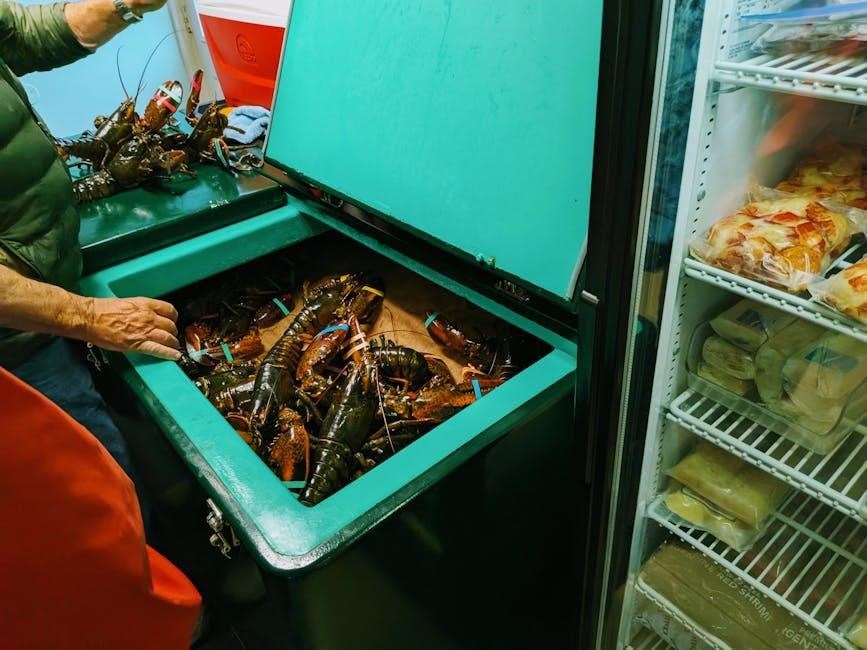Refrigeration is a thermodynamic process that maintains temperatures below ambient by transferring heat from a cooler to a warmer location, essential for preserving food and materials.
1.1 Overview of Refrigeration Technology
Refrigeration technology involves the transfer of heat from a cooler to a warmer location, maintaining temperatures below ambient. It is a thermodynamic process essential for preserving food, medicines, and materials. The technology relies on components like compressors, condensers, evaporators, and expansion valves to facilitate the refrigeration cycle. Its applications are vast, ranging from domestic appliances to industrial plants. The core principle revolves around the compression and expansion of refrigerants to absorb and release heat. This technology ensures the longevity and quality of perishable items, making it indispensable in modern society. Its evolution has led to energy-efficient systems, addressing both performance and environmental concerns.
1.2 Historical Background and Development
The concept of refrigeration dates back to ancient civilizations, but its modern form began in the 19th century with the development of vapor-compression systems. In 1805, Oliver Evans proposed the first vapor-compression refrigeration machine, while Jacob Perkins built the first practical model in 1834. The 1850s saw significant advancements, with James Harrison and Ferdinand Carré pioneering mechanical refrigeration. The 20th century introduced chlorofluorocarbons (CFCs) and later eco-friendly refrigerants. Over time, refrigeration technology evolved to improve efficiency, safety, and environmental sustainability, becoming a cornerstone of modern society. This historical journey reflects humanity’s ingenuity in harnessing thermodynamics to meet growing demands for cooling solutions.

The Refrigeration Cycle
The refrigeration cycle is a thermodynamic process that transfers heat from a cooler to a warmer location, enabling cooling through evaporation, compression, condensation, and expansion stages.
2.1 Basic Principles of the Refrigeration Cycle
The basic principles of the refrigeration cycle involve transferring heat from a low-temperature source to a high-temperature sink through a working fluid, known as a refrigerant. This process occurs in four stages: evaporation, compression, condensation, and expansion. During evaporation, the refrigerant absorbs heat from the surrounding environment, cooling it down. The compressor then raises the temperature and pressure of the refrigerant vapor, which is cooled back into a liquid during condensation. Finally, the expansion valve reduces the pressure, allowing the refrigerant to expand and restart the cycle. This continuous process maintains the desired low temperature in a refrigerated space, making it essential for applications like food storage and air conditioning. The cycle relies on the thermodynamic properties of the refrigerant and the efficient operation of system components to achieve optimal cooling. Understanding these principles is crucial for designing and optimizing refrigeration systems across various industries.
2.2 Four Stages of the Refrigeration Cycle
The refrigeration cycle operates through four distinct stages: evaporation, compression, condensation, and expansion. During evaporation, the refrigerant absorbs heat from the surrounding environment, cooling it down and turning into vapor. The compressor then compresses this vapor, raising its temperature and pressure. In the condenser, the high-temperature vapor releases heat to a cooling medium, condensing back into liquid. Finally, the expansion valve reduces the pressure of the liquid refrigerant, allowing it to expand and re-enter the evaporator, restarting the cycle. These sequential stages ensure efficient heat transfer and maintain the desired cooling effect in refrigeration systems. Each stage is critical for the overall functionality of the cycle.
2.3 Thermodynamic Basis of the Refrigeration Cycle
The refrigeration cycle is rooted in thermodynamic principles, primarily the second law, which governs heat transfer and entropy. It involves reversing the natural flow of heat from a cooler to a warmer location. The process aligns with the Carnot cycle, an idealized thermodynamic cycle, to achieve maximum efficiency. Refrigerants, with specific thermodynamic properties like latent heat and specific heat capacity, facilitate heat absorption and release. The cycle operates by manipulating the refrigerant’s state (liquid-vapor) through compression, condensation, expansion, and evaporation. Practical systems deviate from ideal efficiency due to irreversibilities like friction and heat losses, but the thermodynamic framework remains foundational for design and optimization.

Key Components of Refrigeration Systems
Refrigeration systems rely on essential components like compressors, condensers, evaporators, and expansion valves, each playing a critical role in the heat transfer and refrigerant flow processes.
3.1 Compressor: Role and Function
The compressor is the heart of a refrigeration system, responsible for compressing the refrigerant vapor, raising its temperature and pressure. It drives the refrigeration cycle by converting electrical energy into thermal energy, ensuring the refrigerant flows through the system. The compressor suction intake draws low-pressure vapor from the evaporator and discharges high-pressure vapor to the condenser. Various types, such as reciprocating, screw, and scroll compressors, are used depending on the application. Proper maintenance is crucial for efficient operation and to prevent energy losses, ensuring optimal system performance and reliability.
3.2 Condenser: Design and Operation
The condenser is a critical component in refrigeration systems, designed to dissipate heat from the compressed refrigerant vapor to the surrounding environment. It converts the high-pressure vapor into liquid by cooling it, ensuring the refrigerant can flow through the expansion valve. Typically, condensers are air-cooled or water-cooled, with fins or tubes to enhance heat transfer. Proper airflow and water supply are essential for efficient operation. The condenser’s performance directly impacts the system’s overall efficiency and cooling capacity, making it a key factor in maintaining optimal refrigeration cycle functionality and preventing overheating issues.
3.3 Evaporator: Heat Exchange Process
The evaporator is a vital component where the refrigerant absorbs heat from the surrounding environment, causing the liquid refrigerant to vaporize. This heat exchange process lowers the temperature of the space or material being cooled. The evaporator’s design typically includes coils or tubes filled with refrigerant, allowing it to absorb heat effectively. As the refrigerant evaporates, it transitions from a low-pressure liquid to a gas, preparing it for compression. Efficient operation relies on proper airflow and refrigerant flow control, ensuring optimal heat absorption and maintaining the desired cooling effect. This process is fundamental to achieving the refrigeration system’s cooling objective.

3.4 Expansion Valve: Purpose and Mechanism
The expansion valve is a critical component that reduces the pressure of the refrigerant as it flows from the condenser to the evaporator. This pressure reduction allows the refrigerant to expand and change phase from liquid to vapor. The valve acts as a restriction device, creating a pressure drop that lowers the refrigerant’s temperature and prepares it for heat absorption in the evaporator. By precisely controlling the refrigerant flow, the expansion valve ensures efficient operation of the refrigeration cycle. Its proper functioning is essential for maintaining the balance between refrigerant flow and system performance, directly impacting the overall cooling efficiency of the system.

Working Principles of Refrigeration
Refrigeration operates by transferring heat from a cooler to a warmer location, using components like compressors and evaporators to facilitate thermodynamic processes, enabling cooling through phase changes.
4.1 Vapor-Compression Refrigeration Cycle
The vapor-compression refrigeration cycle is the most widely used method for cooling. It involves four main stages: evaporation, compression, condensation, and expansion. In evaporation, the refrigerant absorbs heat from the surrounding environment, turning into vapor. This vapor is then compressed by the compressor, raising its temperature and pressure. The hot vapor is cooled in the condenser, where it condenses into liquid. Finally, the expansion valve reduces the pressure, allowing the refrigerant to expand and cool before re-entering the evaporator. This continuous cycle enables efficient heat transfer, making it ideal for both domestic and industrial applications.
4.2 Absorption Refrigeration Systems
Absorption refrigeration systems operate without compressors, using a combination of heat and a refrigerant-absorbent solution. The process involves evaporation, absorption, regeneration, and condensation. A refrigerant evaporates, absorbing heat, and is absorbed by a strong absorbent solution. Heat is then applied to separate the refrigerant, which is condensed and reused. Common pairs include water-ammonia and lithium bromide-water. These systems are driven by low-grade heat, making them energy-efficient and environmentally friendly. They are typically quieter and have fewer moving parts than vapor-compression systems, offering reliable performance in industrial and large-scale applications where waste heat is available.
4.3 Role of Refrigerants in the Process
Refrigerants are the working fluids in refrigeration systems, enabling heat transfer between components. They absorb heat from the evaporator, cooling the surrounding area, and release it in the condenser. Common refrigerants include R-134a, R-22, and ammonia. Their properties, such as low boiling points and high latent heat, make them ideal for heat exchange. Proper refrigerant flow and composition are crucial for system efficiency. Environmental concerns, like ozone depletion and global warming, have led to the development of eco-friendly alternatives, such as hydrofluoroolefins (HFOs). Refrigerant management is critical for system performance, safety, and environmental sustainability, ensuring optimal cooling while minimizing ecological impact.
4.4 Importance of Refrigerant Flow Control
Refrigerant flow control is critical for maintaining efficient and stable operation of refrigeration systems. It ensures the proper amount of refrigerant is circulated, preventing overcharging or undercharging, which can degrade performance and lifespan. By regulating flow, systems maintain optimal pressure and temperature, enhancing heat exchange efficiency. This control also reduces wear on components, minimizes leakage risks, and ensures safety. Proper flow control supports eco-friendly performance by reducing refrigerant emissions and energy waste. It is essential for achieving desired cooling capacities and sustaining system reliability, making it a cornerstone of effective refrigeration system design and operation.

Types of Refrigeration Systems
Refrigeration systems are categorized into vapor-compression, absorption, air cycle, and cascade systems, each offering unique advantages for specific applications and efficiency requirements in cooling processes.
5.1 Vapor Compression Refrigeration (VCR)
Vapor Compression Refrigeration (VCR) is the most common type of refrigeration system, utilizing a refrigerant as the working fluid. It operates through a continuous cycle of evaporation, compression, condensation, and expansion. The compressor raises the refrigerant’s pressure and temperature, while the condenser dissipates heat to the surrounding environment. The expansion valve reduces pressure, allowing the refrigerant to evaporate and absorb heat in the evaporator. This process enables efficient heat transfer, making VCR systems highly effective for cooling in both domestic and industrial applications. Their reliability, versatility, and wide range of capacities contribute to their widespread use in modern refrigeration technology.
5.2 Vapor Absorption Refrigeration (VAR)
Vapor Absorption Refrigeration (VAR) systems use a combination of heat and a working fluid, typically water or ammonia, to absorb refrigerant vapors. Unlike VCR, VAR relies on heat input rather than mechanical compression. A strong solution absorbs the refrigerant, and heat is applied to regenerate the refrigerant, which then condenses and expands. VAR systems are environmentally friendly and efficient, especially when waste heat is available. They are commonly used in large-scale industrial and commercial applications, offering a sustainable alternative to traditional compression-based systems. Their ability to utilize renewable energy sources further enhances their appeal in modern, eco-conscious refrigeration solutions.
5.3 Air Cycle Refrigeration Systems
Air Cycle Refrigeration Systems operate on the reverse Brayton or Joule cycle, using air as the working fluid. These systems compress air, cool it, expand it, and then re-circulate it to absorb heat. Unlike vapor-compression systems, air cycle refrigeration doesn’t require refrigerants, making it environmentally friendly. It is commonly used in aircraft and industrial applications where simplicity and safety are prioritized. The system consists of a compressor, turbine, and heat exchangers. Air cycle systems are less efficient than vapor-compression systems but offer advantages in low-maintenance and suitability for cryogenic applications. They are also scalable for various cooling needs, making them versatile in specialized refrigeration scenarios.
5.4 Cascade Refrigeration Systems
Cascade refrigeration systems employ multiple refrigeration cycles arranged in series to achieve ultra-low temperatures. These systems use different refrigerants in each stage, with the first cycle cooling the second. The process involves compressing, condensing, and expanding refrigerants sequentially, allowing for efficient heat transfer at lower temperatures. Cascade systems are widely used in industrial applications, such as liquefying gases like oxygen and nitrogen. They offer high efficiency for extreme cooling needs but require precise control of refrigerant flow and pressure. These systems are also environmentally friendly when using eco-friendly refrigerants, making them suitable for cryogenic applications and large-scale industrial cooling requirements.

Performance Measurement and Efficiency
Performance is measured by Coefficient of Performance (COP), assessing efficiency. Energy efficiency ratings and system capacity relative to input power are critical for optimal refrigeration operation and energy savings.

6.1 Coefficient of Performance (COP)
The Coefficient of Performance (COP) is a key metric for evaluating refrigeration system efficiency, defined as the ratio of heat removed to the work input. A higher COP indicates better energy utilization. COP is crucial for assessing system performance and comparing different refrigeration technologies. It helps in optimizing energy consumption and reducing operational costs; By measuring COP, engineers can identify inefficiencies and implement improvements. Regular monitoring ensures systems operate within desired efficiency levels, contributing to overall energy savings and sustainability goals. COP is a fundamental parameter in the design and operation of modern refrigeration systems.
6.2 Factors Affecting System Efficiency
System efficiency in refrigeration is influenced by various factors, including refrigerant type, compressor performance, and heat exchanger design. Refrigerant properties, such as latent heat and specific heat, play a significant role. Compressor efficiency and operating conditions, like suction and discharge pressures, also impact performance. Heat exchanger effectiveness, including fouling and airflow, affects heat transfer rates. Additionally, system design parameters, such as piping layout and expansion valve operation, contribute to efficiency. Environmental factors like ambient temperature and humidity can also influence system performance. Regular maintenance, including filter cleaning and refrigerant charge optimization, is essential to sustain efficiency levels and ensure reliable operation.
6.3 Energy Savings Opportunities
Energy savings in refrigeration systems can be achieved through various strategies. Upgrading to high-efficiency compressors and optimizing condenser and evaporator performance are key. Implementing smart controls, such as demand-responsive systems, can reduce energy use by adjusting operations based on load demand. Using natural refrigerants with lower global warming potential can enhance efficiency and reduce environmental impact. Improving insulation and minimizing refrigerant leaks also contribute to energy conservation. Regular maintenance, including cleaning coils and servicing expansion valves, ensures optimal performance. Additionally, advanced technologies like inverter-driven compressors and heat recovery systems offer significant energy savings opportunities in modern refrigeration applications.

Applications of Refrigeration Technology
Refrigeration technology is essential in domestic, industrial, and commercial sectors for preserving food, cooling processes, and maintaining cryogenic conditions, ensuring efficiency and safety across diverse applications.
7.1 Domestic Refrigeration Systems
Domestic refrigeration systems are integral to household food preservation, maintaining freshness and safety. These systems typically use vapor-compression cycles, where compressors, condensers, evaporators, and expansion valves work together to transfer heat from the interior to the exterior. Modern designs prioritize energy efficiency, with features like inverter technology and smart sensors optimizing performance. Proper maintenance, including sealing leaks and ensuring refrigerant flow, is crucial for reliability. These systems are essential for everyday life, reducing food waste and enhancing convenience.
7.2 Industrial Refrigeration Plants
Industrial refrigeration plants are large-scale systems designed for cooling processes in manufacturing, food processing, and storage. They often use vapor-compression or absorption systems, operating at lower temperatures than domestic units. These plants are critical for preserving perishable goods, controlling humidity, and maintaining product quality. Industrial systems are highly customizable, with advanced controls for precise temperature management. They typically require significant energy input but are optimized for efficiency. Applications include food storage, chemical processing, and pharmaceutical manufacturing. Proper maintenance and regulation compliance are essential to ensure safety and performance, making them indispensable in various industrial sectors.
7.3 Commercial Refrigeration Systems
Commercial refrigeration systems are essential for retail and food service sectors, ensuring food safety and quality. They are widely used in supermarkets, restaurants, and convenience stores. These systems maintain precise temperature and humidity levels to prevent spoilage and extend shelf life. Common applications include display cases, walk-in coolers, and refrigerated storage units. Energy efficiency is a key focus, with many systems optimized to minimize energy consumption while maintaining performance. Advanced controls and monitoring systems are often integrated to ensure optimal operation. Proper design, installation, and maintenance are critical to uphold performance and compliance with health regulations, making these systems vital for the food industry.
7.4 Cryogenic Refrigeration Applications
Cryogenic refrigeration involves cooling materials to extremely low temperatures, often below -150°C, using liquefied gases like nitrogen or helium. This technology is crucial in medical, scientific, and industrial fields. Applications include preserving biological samples, supercooling materials for research, and storing organs for transplantation. Cryogenic systems are also used in the production of superconductors and magnetic resonance imaging (MRI) machines. These systems ensure the integrity and functionality of materials at cryogenic temperatures, enabling advancements in various sectors. The precise temperature control and reliability of cryogenic refrigeration make it indispensable for cutting-edge applications requiring extreme cooling conditions, supporting innovation and critical operations across multiple industries worldwide.

Environmental Considerations
Refrigeration systems must address environmental impacts, including refrigerant safety, energy consumption, and emissions. Regulations ensure eco-friendly practices and sustainable solutions to minimize ecological harm and promote efficiency.
8.1 Refrigerant Safety and Regulations
Refrigerant safety and regulations are critical to prevent environmental harm and ensure system efficiency. Stricter laws now govern refrigerant use, focusing on reducing emissions and phasing out harmful substances like chlorofluorocarbons (CFCs) and hydrochlorofluorocarbons (HCFCs). The Montreal Protocol and EU regulations mandate the adoption of eco-friendly alternatives, such as hydrofluoroolefins (HFOs) and natural refrigerants. Proper handling, storage, and disposal of refrigerants are enforced to minimize leaks and contamination. Safety standards also address potential risks to human health and the environment, ensuring compliance with international guidelines. These measures aim to balance refrigeration needs with sustainable and responsible practices, safeguarding both people and the planet for future generations.
8.2 Environmental Impact of Refrigerants
Refrigerants significantly impact the environment, primarily through ozone depletion and global warming. Chlorofluorocarbons (CFCs) and hydrochlorofluorocarbons (HCFCs) deplete the ozone layer, while hydrofluorocarbons (HFCs) contribute to greenhouse gas emissions. Leaks from refrigeration systems release these substances, exacerbating climate change and ozone layer damage. Regulations now promote alternatives like hydrofluoroolefins (HFOs) and natural refrigerants, which have lower global warming potentials. Transitioning to eco-friendly refrigerants is crucial to mitigate environmental impacts and meet international climate agreements. Proper handling and disposal of refrigerants are essential to reduce emissions and protect the planet from further harm, ensuring a sustainable future for refrigeration technologies.
8.3 Energy Efficiency and Sustainability
Energy efficiency is critical for sustainable refrigeration systems, reducing operational costs and environmental impact. Modern technologies, such as variable-speed compressors and smart controls, optimize energy use. High-efficiency compressors and improved heat exchanger designs minimize energy consumption. Additionally, using natural refrigerants like CO2 and ammonia reduces reliance on synthetic refrigerants with high global warming potentials. Retrofitting existing systems with energy-efficient components can significantly lower energy consumption. Sustainability initiatives also focus on waste heat recovery, integrating renewable energy sources, and enhancing system maintenance to ensure peak performance. These advancements promote eco-friendly refrigeration while addressing global energy challenges, making systems more sustainable and environmentally responsible over their lifecycle.
8.4 Eco-Friendly Refrigeration Alternatives
Eco-friendly refrigeration alternatives are increasingly adopted to reduce environmental impact. Natural refrigerants like carbon dioxide (CO2), ammonia, and hydrocarbons are replacing synthetic ones due to their lower global warming potential. Magnetic refrigeration, using magnetic fields to induce cooling, is emerging as an energy-efficient, chemical-free option. Absorption and adsorption systems, driven by waste heat, minimize electricity use. Additionally, advanced technologies like ejector systems and decentralized cooling solutions optimize performance while lowering emissions. These alternatives not only comply with environmental regulations but also contribute to a sustainable future by reducing greenhouse gas emissions and promoting energy efficiency in refrigeration processes.
Refrigeration technology has evolved significantly, driving advancements in efficiency and sustainability. Future trends include eco-friendly refrigerants, smart systems, and energy-efficient designs, ensuring a sustainable cooling future.
9.1 Summary of Key Concepts
Refrigeration is a fundamental thermodynamic process that transfers heat from a cooler to a warmer location, enabling temperature control below ambient levels. The refrigeration cycle involves four primary stages: compression, condensation, expansion, and evaporation. Key components include compressors, condensers, evaporators, and expansion valves, working together to circulate refrigerants. These refrigerants play a crucial role in absorbing and releasing heat. The process is essential for preserving food, cooling industrial processes, and maintaining comfort in buildings. Efficiency and sustainability are critical, with advancements focusing on eco-friendly refrigerants and energy-saving technologies. Understanding these principles is vital for optimizing refrigeration systems across various applications, from domestic to industrial scales.
9.2 Emerging Technologies in Refrigeration
Emerging technologies in refrigeration focus on enhancing efficiency, sustainability, and performance. Natural refrigerants like CO2 and ammonia are gaining traction due to their low environmental impact. Inverter-driven compressors optimize energy use by adjusting speeds based on demand. Magnetic refrigeration, using magnetic fields to induce cooling, offers a promising alternative to traditional vapor-compression systems. Additionally, advancements in smart refrigeration integrate AI and IoT for real-time monitoring and energy management. These innovations aim to reduce energy consumption, minimize greenhouse gas emissions, and improve system reliability, paving the way for a more sustainable future in refrigeration technology.
9.3 Future Directions for Sustainable Refrigeration
The future of refrigeration lies in sustainable technologies that minimize environmental impact while meeting growing cooling demands. Transitioning to natural refrigerants and alternative cooling methods, such as magnetic and absorption systems, is crucial. Energy-efficient designs, smart grids, and renewable energy integration will reduce reliance on fossil fuels. Research into advanced materials and nano-technologies aims to enhance heat transfer efficiency. Additionally, industry standards and regulations are evolving to promote eco-friendly practices. Collaboration between governments, manufacturers, and researchers is essential to drive innovation and ensure a sustainable refrigeration industry that supports global climate goals and resource conservation.

